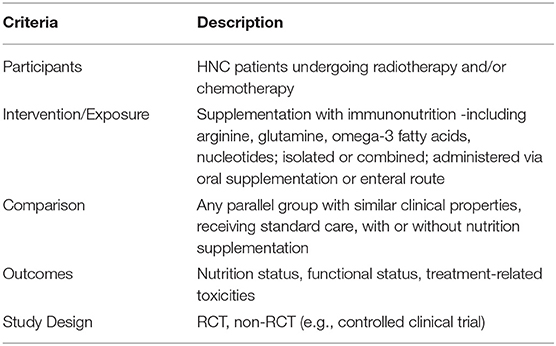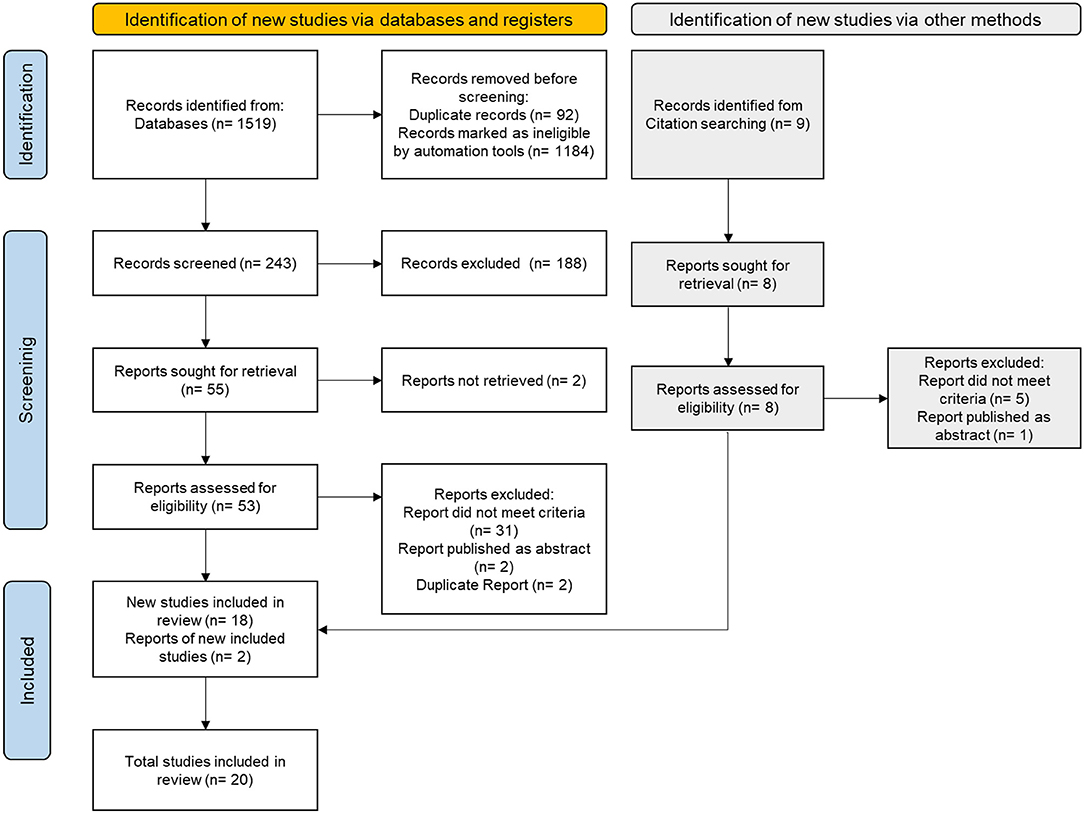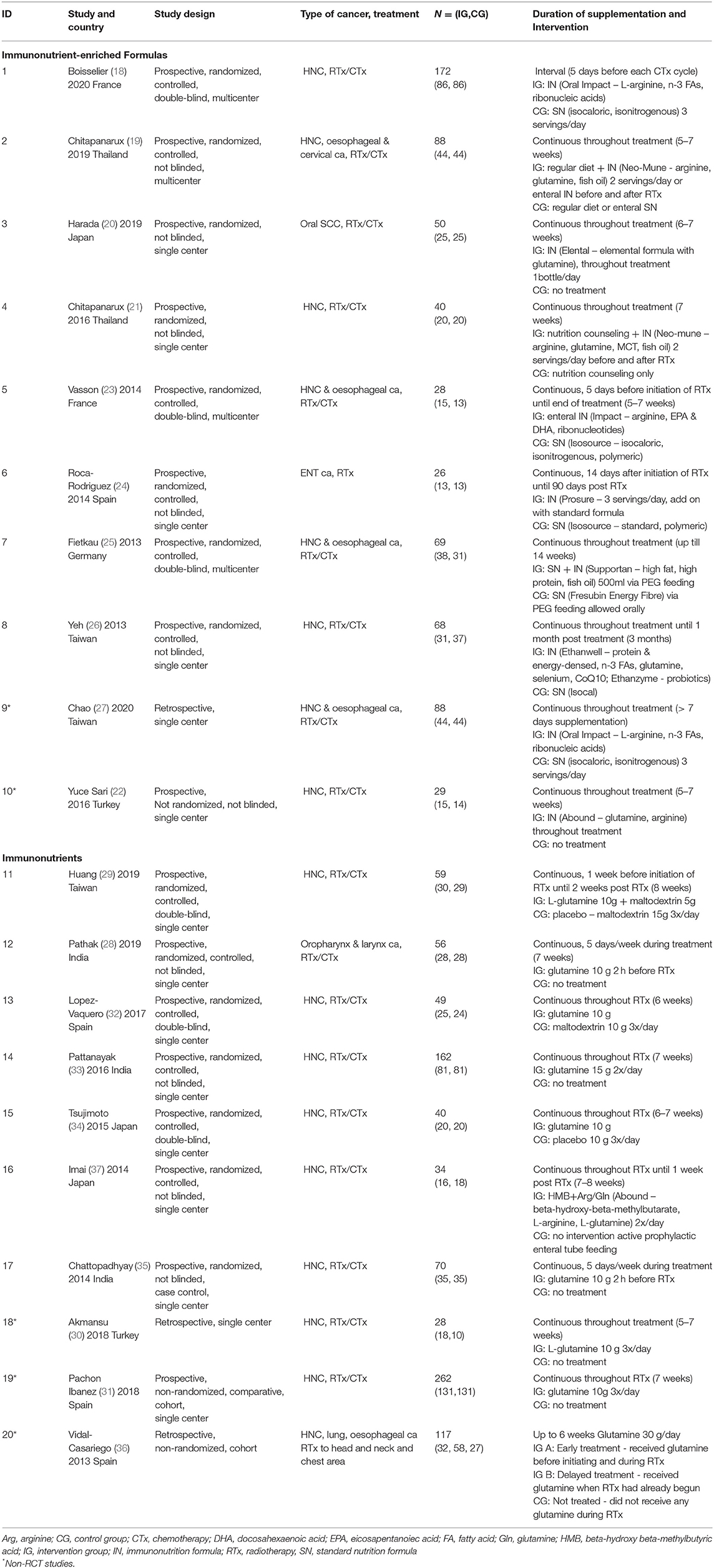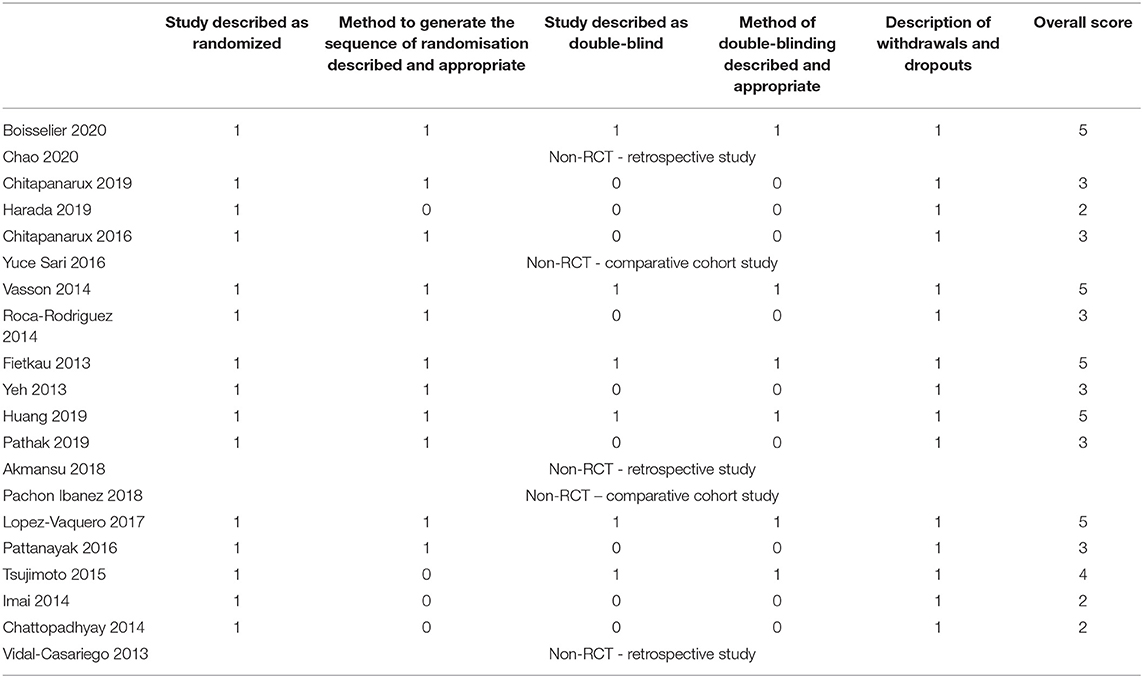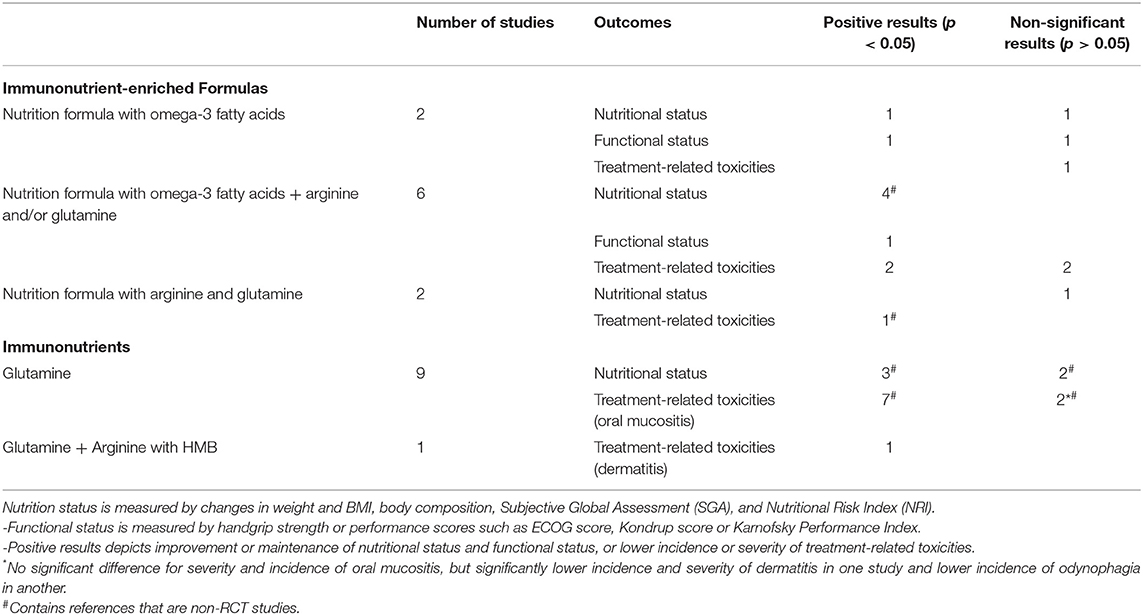- 1Centre for Population Health (CePH), Department of Social and Preventive Medicine, Faculty of Medicine, University of Malaya, Kuala Lumpur, Malaysia
- 2Ministry of Health, Putrajaya, Malaysia
- 3Department of Clinical Oncology, University of Malaya Medical Centre, Kuala Lumpur, Malaysia
- 4Department of Nutrition, Faculty of Public Health, Airlangga University, Surabaya, Indonesia
Background and Aims: Malnutrition is prevalent among head and neck cancer (HNC) patients and leads to undesirable outcomes such as reduced treatment response and increased treatment-related side effects. This systematic review summarizes the recent evidence regarding the effect of immunonutrition in HNC patients undergoing radiotherapy and chemotherapy.
Methods: A literature search was conducted of the CENTRAL, ProQuest, MEDLINE, EBSCOhost, Web of Science and CINAHL databases; and further supplemented with internet and manual searches. Studies published between January 2011 and May 2021 were identified, screened, retrieved, and data extraction was performed.
Results: Twenty studies involving 1535 patients were included, 15 were randomized controlled trials (RCTs), three were retrospective study and two were comparative cohort studies. Five out of seven studies reported improvement or maintenance of nutrition status with continuous supplementation using immunonutrient-enriched formula. Three studies reported functional status as an outcome, with one study reporting significant improvement, one study reporting maintenance, and another study reporting no difference in the functional status of patients supplemented with immunonutrient-enriched formulas. Supplementation with glutamine did not reduce the overall incidence of mucositis but delayed the onset of oral mucositis and had significantly less incidence of severe oral mucositis.
Conclusion: Supplementation with immunonutrient-enriched formulas in HNC patients during radiotherapy and chemotherapy may improve or maintain nutrition status. Supplementation with glutamine during HNC radiotherapy and chemotherapy may delay the onset of oral mucositis and reduce incidences of severe oral mucositis. Further investigations are required, focusing on the timing, dosage, and duration of immunonutrition.
Systematic Review Registration: PROSPERO, identifier CRD42021241817.
Introduction
Head and neck cancer refers to neoplasms occurring in the head and neck region, including the pharynx, nasal, and oral cavity, metastasising to cervical neck nodes. The curative treatment of HNC includes concurrent chemoradiotherapy, radiotherapy alone, or postoperative radiotherapy.
Malnutrition in cancer patients is associated with weight loss, reduced immune competence, increased risk of infections, increased treatment toxicities, and greater mortality risk. The prevalence of malnutrition is very high in cancer patients undergoing treatment (1–3). Patients with primary cancers involving the gastrointestinal tract, head and neck, liver, and lung are exceptionally at high risk of malnutrition (1). In HNC, the prevalence of malnutrition is at an alarming 22–56% upon diagnosis (4–6). Malnutrition in cancer patients can be attributed to inadequate nutritional intake, likely due to primary anorexia or secondary causes (e.g., mucositis, xerostomia, intestinal obstruction, malabsorption, nausea, vomiting, pain, etc.). Additionally, metabolic derangements such as increased metabolism and catabolism further reduce cancer patients' nutrition status. For cancer patients undergoing cancer treatment, malnutrition increases the risk of treatment-related toxicities, resulting in treatment withdrawal and eventual reduction in treatment response.
Immunonutrition can be defined as modulation of either the immune system activity or modulation of the consequences of activation of the immune system by nutrients or specific food items fed in amounts above those typically encountered in the diet (7). Immunonutrients identified and studied are omega-3 fatty acids, glutamine, arginine, branched-chain amino acids, and nucleotides (8–10). Immunonutrition can be provided in the form of immunonutrient-enriched formula, single immunonutrient, or combination of immunonutrients. Immunonutrition was found to reduce the severity of treatment-related toxicities such as oral mucositis, diarrhea, oesophagitis, and weight loss (11, 12). However, the variability in the type, dose, and duration of immunonutrition led to inconsistent outcomes among available evidence.
This systematic review summarizes the recent evidence regarding the effect of immunonutrition in HNC patients undergoing radiotherapy and chemotherapy.
Materials and Methods
This systematic review was designed according to the PICOS criteria outlined in Table 1 and reported according to the Preferred Reporting Items for Systematic Reviews and Meta-Analyses (PRISMA) 2020 Statement guidelines. The protocol of this systematic review was registered in the International Prospective Register of Systematic Reviews (PROSPERO) under the registration number: CRD42021241817.
Search Strategy
A literature search was conducted of six databases: Cochrane Central Register of Controlled Trials (CENTRAL) in The Cochrane Library, ProQuest, MEDLINE (Pubmed), EBSCOhost, Web of Science and CINAHL. The literature search was further supplemented with internet searches (e.g., Google Scholar) and a manual search of the reference lists of relevant studies and previously published systematic reviews. Studies published from January 2011 to May 2021 were included in the search. There were no language restrictions for the studies.
The search strategy included three groups of keywords and Medical Subject Headings (MeSH) terms that describe immunonutrition, head and neck cancer patients, and cancer treatment. Search terms of the same group, such as “immunonutrition,” “immune-enhancing nutrition,” “immune-modulating nutrition,” “glutamine,” “arginine,” omega 3 fatty acid,” “fish oil,” “nucleotides” were combined using Boolean operator OR. Search terms for the three different groups were then combined with the Boolean operator AND (refer to Supplementary Material).
Eligibility Criteria
The inclusion criteria for studies to be considered for this review were (1) primary research involving adult (above 18 years) HNC patients undergoing radiotherapy and or chemotherapy either as primary treatment modality or post-operatively; (2) comparing immunonutrition (combination of immunonutrients or involve at least one immunonutrient – glutamine, arginine, omega 3 fatty acid) vs. standard nutrition (polymeric nutrition formula that is nutritionally complete), or placebo or no nutrition intervention; (3) reported nutrition status, functional status and treatment-related toxicities as outcomes.
Studies that did not meet the inclusion criteria were excluded: involving participants <18 years old, involving participants who did not undergo radiotherapy or chemotherapy, and involving nutrition supplementation via parenteral nutrition. Duplicate and irrelevant studies were also excluded in case reports, letters, reviews, animal or in vitro studies.
Study Selection and Data Collection
The selection of articles involved three stages: (1) selection based on title, (2) abstract consideration, (3) assessing the full text. Two reviewers independently assessed the potentially relevant articles for eligibility. Disagreements are resolved through discussion until consensus is reached. A third reviewer was consulted in the event that no consensus was reached.
Database searches and reference lists were imported into EndNote™ 20, Clarivate Analytics (US) LLC. Data extraction was performed using a data extraction table that collects information such as bibliography information (title, author, publication year, journal, country/institution where the study was conducted), study design, study duration, study population (inclusion/exclusion criteria, sample size, type of cancer, type of treatment), intervention, comparison, outcomes, etc. Study investigators were contacted to clarify or obtain more information when necessary. Two reviewers independently extracted the data. Discrepancies are resolved through discussion until consensus is reached. A third reviewer was consulted in the event no consensus was reached.
Outcomes
The primary outcome specified was nutrition status, which included: changes in weight and BMI, body composition, Subjective Global Assessment (SGA), and Nutritional Risk Index (NRI).
Secondary outcomes that were specified were functional status and treatment-related toxicities. Functional status is measured by handgrip strength or performance scores such as ECOG, Kondrup, or Karnofsky Performance Index. Incidences and severity of treatment-related toxicities are graded using National Cancer Institute Common Terminology Criteria for Adverse Events (CTCAE) v5.0.
Quality and Risk of Bias Assessment
Two reviewers performed the quality and Risk of Bias assessment independently, using the Jadad Scale (13) and Cochrane Risk of Bias Tool (14) for randomized, controlled trials. Results were compared, and any discrepancies were resolved through discussion; a third reviewer was consulted on the occasion where consensus could not be reached. The methodological quality of controlled trials was scored according to three areas – randomisation, masking and accountability. The bias of the studies was rated as High, Low or Unclear; on five specified domains (Selection, Performance, Attrition, Reporting, and Other).
Data Synthesis
Narrative synthesis of the information gathered in the data extraction form is structured around the type of intervention, target population characteristics, type of outcome, and intervention content. Summary of intervention effects were tabulated.
Results
The literature search identified 1,519 articles. Nine other articles were identified through reference list and citation search. Duplicate articles and ineligible articles were removed via automation tools or manual identification. The remaining 243 articles were screened based on title and abstract. The full texts of 62 articles were then retrieved and assessed. Thirty-six studies were excluded because they did not meet the eligibility criteria, and two studies were excluded because of duplication. Three studies published as abstracts were excluded because retrieval of the full manuscript was unsuccessful as there was no reply from the authors (15–17). Finally, a total of 20 studies were included in this systematic review. The study selection process is outlined in Figure 1.
Characteristics of the studies included are summarized in Table 2. The sample size of the studies ranges between 26 and 262, with an accumulative total of 1,535 patients, of which 805 received immunonutrition while 730 received standard nutrition or placebo or no treatment. The studies are categorized according to the type of intervention, including supplementation using immunonutrient-enriched formula, or supplementation using a single immunonutrient or combination of immunonutrients. Ten studies involved supplementation using immunonutrient-enriched formula (18–27), while nine studies involved the supplementation of a single immunonutrient (glutamine) (28–36), and one study involved supplementation of immunonutrients (glutamine and arginine) with hydroxy-beta-methylbutarate (37). Majority of the studies involved only HNC on radiotherapy with or without chemotherapy, except for five studies that involved HNC and oesophageal cancer patients in their study population (19, 23, 25, 36, 38).
Most of the studies involved immunonutrition as oral nutrition supplements and are only administered via a feeding tube when the subjects were unable to tolerate it orally. For the three studies that involved oesophageal cancer patients, the immunonutrient-enriched formula was administered via a feeding tube upon initiation of intervention (19, 23, 25).
Quality and Risk of Bias Assessment
The risk of bias of the included studies was evaluated using the Cochrane Risk of Bias Tool for Randomized Control Trials and summarized in Figure 2. Out of the 15 studies that were evaluated, seven were classified under low risk of bias, four were classified as high risk of bias, and four were judged to have raised some concerns of risk of bias. The most common source of bias was performance bias (i.e., blinding of participants and personnel). Seven studies were non-blinded as they were either open-label studies or the control group did not receive any treatment. For selection bias, four studies did not describe in detail the randomisation process or participant allocation. Therefore, the risk of bias was unclear. In terms of detection bias, five studies did not describe if the outcome assessors were blinded to the intervention allocation or not. Hence the risk of bias was unclear. Finally, for attrition bias, five studies were classified as high risk as there was more than 10% dropout or loss of sample.
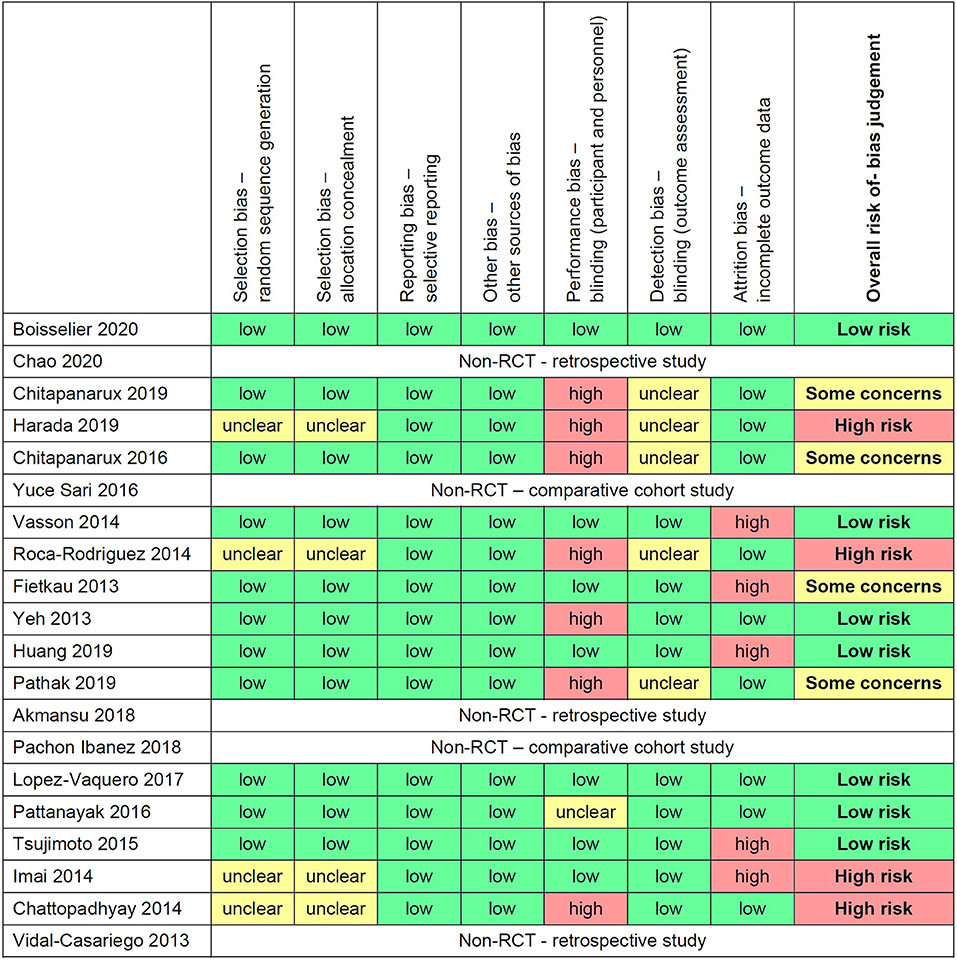
Figure 2. Summary of risk of bias assessment using the Cochrane Risk of Bias Tool for Randomized Control Trails.
The quality of the clinical trials was also assessed using the Jadad scale and summarized in Table 3. Twelve studies were of high quality (score between 3 and 5), whereas three were low quality (score between 0 and 2).
Immunonutrient-Enriched Nutrition Formula
Ten studies evaluated the effects of immunonutrient-enriched nutrition formulas. Of these, three involved nutrition formula enriched with arginine and omega-3 fatty acids (18, 23, 27); two involved nutrition formula enriched with omega-3 fatty acids (24, 25); two involved nutrition formula enriched with arginine, glutamine and omega-3 fatty acids (19, 21); one involved nutrition formula enriched with glutamine and arginine (22); one involved elemental nutrition formula containing glutamine (20); and one involved nutrition formula enriched with glutamine and omega-3 fatty acids (26). In terms of methodological quality, seven out of 10 of the studies were of good quality.
Most studies involved continuous supplementation during and throughout the radiotherapy and chemotherapy treatment, except for Boisselier et al. that provided immunonutrient-enriched formula in intervals (5 days before each chemotherapy cycle) (18); Roca-Rodriguez et al. that started immunonutrient-enriched formula 14 days after initiation of radiotherapy and continued up to 90 days post-radiotherapy treatment (24); and Yeh et al. that continued the immunonutrient-enriched formula until one-month post-radiotherapy treatment (26).
In terms of nutritional status, five studies found significant improvements in the nutrition status for patients in the intervention group (21, 23, 25–27). On the other hand, two studies observed no difference between the intervention and control groups (20, 24). For treatment-related toxicities, three studies reported reduced incidence and severity of oral mucositis in the intervention group (20–22), while three other studies found no difference between groups (18, 23, 24). Hematological toxicities were reported to be higher in the control group by two studies (19, 21), while one study reported no difference between groups (24). Only three studies measured functional status as an outcome. Fietkau et al. reported significantly improved functional status (improved Karnofsky Performance Index score) in the intervention group (25), Vasson et al. reported maintenance of functional status in the intervention group compared to the control group who had deterioration of functional status (increased WHO Performance Status score and decreased Karnofsky Index score) (23), while Roca-Rodriguez et al. reported no difference in the functional status between control and the intervention group (24). The results of the studies are summarized in Tables 4, 5.
Glutamine
Nine studies evaluated the effects of supplementation with single immunonutrient (glutamine) vs. placebo or no treatment (28–36). All studies involved continuous supplementation with 10 to 30 grams of glutamine per day and supplementation period ranging between five to eight weeks. One study involved continuous supplementation until one-week post-treatment with a combination of immunonutrients (arginine and glutamine) with HMB (37). However, only five studies were classified as having good methodological quality, with a Jadad score between 3 and 5. Two studies were of poor methodological quality, and three other studies were non-randomized controlled trials.
Three studies found no difference in the overall incidence of oral mucositis between the control and intervention groups (31, 32, 35). One study found no difference between groups for the onset of mucositis and mucositis duration (34). However, four studies reported delayed onset of oral mucositis in patients supplemented with glutamine (28, 30, 33, 35). Furthermore, four studies reported a lower incidence of severe oral mucositis in the intervention group than in the control group (29, 30, 33, 35). The severity of oral mucositis was also reported to be significantly lower in the intervention group (28, 34).
Significantly later onset of dysphagia and less severe dysphagia (28) were observed in patients receiving glutamine compared to those who received placebo or no treatment. There were also reports of lower incidences of dermatitis (32, 37) and a shorter duration of dermatitis in the intervention group (37). However, another study found no difference in the development of dermatitis between the two groups (29). Significant weight loss was reported by two studies in the control group compared to the intervention group (28, 34), while two studies reported no difference between the two groups (30, 32). Tsujimoto et al. reported lower NRS scores in patients receiving glutamine supplementation (34).
Interestingly, Vidal-Casariego et al. evaluated the effects of early supplementation with glutamine against delayed supplementation with glutamine and no supplementation (36). There was a significant difference in the development of oral mucositis, whereby 75% of those with early supplementation, 94.7% of those with delayed supplementation, and 100% of those without supplementation developed oral mucositis. Less severe oral mucositis was also observed in patients who received early supplementation of glutamine. The same study also reported lower incidence and a smaller degree of weight loss in patients with early supplementation of glutamine, followed by delayed supplementation and no supplementation.
Discussion
This systematic review summarizes recent evidence regarding the effect of immunonutrition in HNC patients undergoing radiotherapy and chemotherapy in nutrition status, functional status, and treatment-related toxicities.
Radiotherapy with or without chemotherapy is the most common mode of treatment for HNC as primary treatment or postoperative treatment (39). Even though current cancer treatment modalities are effective for tumor control; they are also associated with acute and late toxicities. Radiotherapy to the head and neck region is site-specific and localized, causing direct damage to cells in that area. This can damage nearby food consumption or digestion structures, such as taste buds and salivary glands. This will affect the early digestion process and taste changes, eventually leading to a loss of appetite and desire to consume food. Chemotherapy side effects can also lead to gastrointestinal symptoms, loss of appetite, and exacerbate radiotherapy side effects. Previous literature reported that HNC patients are at exceptionally high risk of malnutrition before initiation of radiotherapy and chemotherapy, and their nutrition status deteriorate further as the treatment progresses (6, 40–43).
Glutamine is a conditionally essential amino acid during metabolic stress. It is the primary fuel for the proliferation of lymphocytes, production of cytokines, and macrophage phagocytic and secretory activities (44). It is also the precursor for amino acids, proteins, nucleotides synthesis, and ammoniagenesis in the kidneys (45). Hence, glutamine may be beneficial in reducing mucosal damage during cancer treatment, including mucositis, stomatitis, pharyngitis, esophagitis and enteritis; and promote mucosal healing during and post-cancer treatment (46, 47). Arginine is involved in nucleotides, polyamines, nitric oxide, ornithine, citrulline and proline synthesis. Therefore, arginine has an essential role in the modulation of immune function, regulation of blood flow, angiogenesis and wound healing (46, 48). Omega-3 fatty acids, namely eicosapentaenoic acid (EPA) and docosahexaenoic acid (DHA), modulates the immune system by reducing the production of pro-inflammatory arachidonic acid (AA) and competes with AA for cyclooxygenase and lipoxygenase enzymes (49). Past literature suggests that omega-3 fatty acids may be associated with anticatabolic and antilipolytic activities (50).
The present systematic review found that overall, continuous supplementation with immunonutrient-enriched formulas may improve or maintain the nutrition status of HNC patients undergoing radiotherapy and chemotherapy. Six out of seven studies that implemented supplementation with immunonutrient-enriched formula during chemoradiation reported significant positive results in the intervention group compared to the control group receiving isocaloric, isonitrogenous nutrition supplementation or standard nutrition care. Maintenance or improvement in nutrition status is observed in subjects supplemented with formulas enriched with different combinations of omega-3 fatty acids with arginine and or glutamine. Even though nutrition status plays an essential role in the tolerance to treatment, treatment outcomes and survival, only 13 studies reported nutrition status as an outcome. It is also observed that the indicators used to measure nutritional status differ vastly among the studies. The most common indicator is weight or percentage of weight loss, while indicators like body composition or mid-arm circumference are less commonly used to measure nutrition status.
Changes in the functional status of HNC patients during cancer treatment is an important area in cancer management that have been of interest in the past two decades. Radiotherapy and chemotherapy treatment-related side effects such as oral pain, swallowing difficulty and nausea, can impair patients' quality of life significantly. However, the present systematic review only identified three studies that reported changes in the functional status of patients as an outcome of supplementation with immunonutrition. Two out of three studies reported improved functional status (Karnofsky Index scores) in the intervention group receiving immunonutrient-enriched formulas.
Studies that implemented supplementation with glutamine mostly reported treatment-related toxicities as the primary outcome, namely oral mucositis. Mucositis is the most common treatment side effect that occurs in HNC patients undergoing radiotherapy. In the present systematic review, three studies reported that there was no difference between groups being observed in terms of overall incidence (all grades) of oral mucositis. However, delayed onset of oral mucositis, less severe oral mucositis and lower incidence of severe oral mucositis was reported in eight other studies. Nutrition status was reported as a secondary outcome in seven studies. However, only three studies found significant positive results (less weight loss than the control group), while another two studies did not find any significant difference between the control and intervention groups. Even though glutamine was given in a modular supplementation, there were still positive outcomes in the nutrition status. This may be due to less severe oral mucositis in the intervention group, allowing for adequate intake of regular diet and oral nutrition supplement.
The present systematic review has several limitations. Due to the broad inclusion criteria, this systematic review included varied study designs, supplementation regimes and duration, and outcome measurements. The variability is high among studies that have been conducted in terms of timing and duration of supplementation, type of formula or combinations of immunonutrients, and dosage of immunonutrients or immunonutrient-enriched nutrition formula. Some studies included other primary cancer sites besides HNC, such as oesophageal, cervical and lung. Hence the outcomes were also inconsistent between studies. There were also very few RCTs with a large sample size. Furthermore, methodological quality and risk of bias were also of varying degrees, making it difficult to perform a more robust analysis or draw conclusions from the limited evidence available.
Even though our findings may not be conclusive, the positive effects of immunonutrition in HNC patients, whether in immunonutrient-enriched formula, or supplementation of single immunonutrient, or combination of immunonutrients; is still worth being investigated in future studies. Based on the systematic review findings, future studies should focus on well-designed, randomized controlled trials to investigate the effects of different dosages and combinations of immunonutrients in nutritional and functional status. Finally, future trials should also be more progressive, looking into the impact of timing and duration of immunonutrition, including supplementation prior to cancer treatment and continuation of nutrition supplementation post-treatment, which may further optimize the nutrition status of HNC patients and lead to better treatment outcomes.
Conclusion
In conclusion, the present review found that supplementation with immunonutrient-enriched formulas in HNC patients during radiotherapy and chemotherapy may improve or maintain nutrition status. Supplementation with glutamine during HNC radiotherapy and chemotherapy may delay the onset of oral mucositis and reduce the incidence of severe oral mucositis. However, these findings are not conclusive, given the studies heterogeneity. Therefore, further investigations are encouraged in the future, focusing on the timing, dosage and duration of immunonutrition required for nutrition optimisation.
Data Availability Statement
The original contributions presented in the study are included in the article/Supplementary Material, further inquiries can be directed to the corresponding author.
Author Contributions
ST and HM contributed equally to the conception and design of the manuscript amd critical appraised the data selected. ST conducted the data collection and analysis and drafted the manuscript. All authors critically revised the manuscript, agree to be accountable for all aspects of work ensuring the integrity and accuracy of the manuscript, and read and approved the final manuscript. All authors contributed to the article and approved the submitted version.
Funding
This review was funded by the University of Malaya Research Management Institute (RMF0002-2020). The sponsors had no role in the preparation of this manuscript. They did not take part in the design of the study, analysis and interpretation of data.
Conflict of Interest
The authors declare that the research was conducted in the absence of any commercial or financial relationships that could be construed as a potential conflict of interest.
Publisher's Note
All claims expressed in this article are solely those of the authors and do not necessarily represent those of their affiliated organizations, or those of the publisher, the editors and the reviewers. Any product that may be evaluated in this article, or claim that may be made by its manufacturer, is not guaranteed or endorsed by the publisher.
Acknowledgments
The authors would like to thank Darwish Mohd Isa (Department of Social and Preventive Medicine, Faculty of Medicine, University of Malaya) for his valuable cooperation and support during study selection and data extraction.
Supplementary Material
The Supplementary Material for this article can be found online at: https://www.frontiersin.org/articles/10.3389/fnut.2022.821924/full#supplementary-material
Supplementary Material 1. Search Strategy for the Systematic Review.
References
1. Arends J, Baracos V, Bertz H, Bozzetti F, Calder PC, Deutz NEP, et al. ESPEN expert group recommendations for action against cancer-related malnutrition. Clin Nutr. (2017) 36:1187–96. doi: 10.1016/j.clnu.2017.06.017
2. Yalcin S, Gumus M, Oksuzoglu B, Ozdemir F, Evrensel T, Sarioglu AA, et al. Nutritional Aspect of Cancer Care in Medical Oncology Patients. Clin Ther. (2019) 41:2382–96. doi: 10.1016/j.clinthera.2019.09.006
3. Bossi P, Delrio P, Mascheroni A, Zanetti M. The Spectrum of Malnutrition/Cachexia/Sarcopenia in Oncology According to Different Cancer Types and Settings: A Narrative Review. Nutrients. (2021) 13:1980. doi: 10.3390/nu13061980
4. Einarsson S, Laurell G, Tiblom Ehrsson Y. Mapping the frequency of malnutrition in patients with head and neck cancer using the GLIM Criteria for the Diagnosis of Malnutrition. Clin Nutr ESPEN. (2020) 37:100–6. doi: 10.1016/j.clnesp.2020.03.011
5. Steer B, Loeliger J, Edbrooke L, Deftereos I, Laing E, Kiss N. Malnutrition Prevalence according to the GLIM Criteria in Head and Neck Cancer Patients Undergoing Cancer Treatment. Nutrients. (2020) 12:3493. doi: 10.3390/nu12113493
6. Neoh MK, Abu Zaid Z, Mat Daud ZA, Md Yusop NB, Ibrahim Z, Abdul Rahman Z, et al. Changes in Nutrition Impact Symptoms, Nutritional and Functional Status during Head and Neck Cancer Treatment. Nutrients. (2020) 12:1225. doi: 10.3390/nu12051225
7. Grimble RF. Basics in clinical nutrition: Immunonutrition – Nutrients which influence immunity: Effect and mechanism of action. E Spen Eur E J Clin Nutr Metab. (2009) 4:e10–e3. doi: 10.1016/j.eclnm.2008.07.015
8. Worthington ML, Cresci G. Immune-modulating formulas: who wins the meta-analysis race? Nutr Clin Pract. (2011) 26:650–5. doi: 10.1177/0884533611425799
9. Howes N, Atkinson C, Thomas S, Lewis SJ. Immunonutrition for patients undergoing surgery for head and neck cancer. Cochrane Database Syst Rev. (2018) 8:Cd010954. doi: 10.1002/14651858.CD010954.pub2
10. Prieto I, Montemuiño S, Luna J, de Torres MV, Amaya E. The role of immunonutritional support in cancer treatment: current evidence. Clin Nutr. (2017) 36:1457–64. doi: 10.1016/j.clnu.2016.11.015
11. Zheng XY, Yu KL, Wang GY, Liu M, Li YH, Yu PL, et al. Effects of Immunonutrition on Chemoradiotherapy Patients: a systematic review and meta-analysis. J Parenter Enteral Nutr. (2020) 44:768–78. doi: 10.1002/jpen.1735
12. Lyra MDF, de Meira JEC, Guedes GD, Bueno NB. Immunonutrition in head and neck cancer: Systematic review and metanalysis of its clinical and nutritional effects. Clin Nutr Espen. (2021) 41:30–41. doi: 10.1016/j.clnesp.2020.12.014
13. Jadad AR, Moore RA, Carroll D, Jenkinson C, Reynolds DJ, Gavaghan DJ, et al. Assessing the quality of reports of randomized clinical trials: is blinding necessary? Control Clin Trials. (1996) 17:1–12. doi: 10.1016/0197-2456(95)00134-4
14. Higgins JPT SJ, Page MJ, Elbers RG, Sterne JAC. Chapter 8: Assessing risk of bias in a randomized trial. In: Higgins JPT TJ, Chandler J, Cumpston M, Li T, Page MJ, Welch VA, editor. Cochrane Handbook for Systematic Reviews of Interventions version 62 (updated February 2021). Cochrane (2021).
15. Chang JT. The effect of eicosapentaenoic acid in patients with nasopharyngeal cancer receiving concurrent chemoradiotherapy in an outpatient clinic: An open-label prospective randomized trial. J Clin Oncol. (2011) 29:e19550. doi: 10.1200/jco.2011.29.15_suppl.e19550
16. Pareek V, Bhalavat R, Chandra ML. Glutamine in reducing severity of oral mucositis due to chemoradiation in head and neck cancer. Radiother Oncol. (2017) 123:S577-S. doi: 10.1016/S0167-8140(17)31481-0
17. Perumal K, Reddy PK, Potharaju M. Impact of glutamine supplements in altering the toxicity profile in head and neck cancer patients receiving concurrent chemoradiotherapy. Ann Oncol. (2016) 27:ix115. doi: 10.1016/S0923-7534(21)00527-5
18. Boisselier P, Kaminsky MC, Thézenas S, Gallocher O, Lavau-Denes S, Garcia-Ramirez M, et al. A double-blind phase III trial of immunomodulating nutritional formula during adjuvant chemoradiotherapy in head and neck cancer patients: IMPATOX. Am J Clin Nutr. (2020) 112:1523–31. doi: 10.1093/ajcn/nqaa227
19. Chitapanarux I, Traisathit P, Chitapanarux T, Jiratrachu R, Chottaweesak P, Chakrabandhu S, et al. Arginine, glutamine, and fish oil supplementation in cancer patients treated with concurrent chemoradiotherapy: A randomized control study. Curr Probl Cancer. (2020) 44:100482. doi: 10.1016/j.currproblcancer.2019.05.005
20. Harada K, Minami H, Ferdous T, Kato Y, Umeda H, Horinaga D, et al. The Elental (R) elemental diet for chemoradiotherapy-induced oral mucositis: a prospective study in patients with oral squamous cell carcinoma. Mol Clin Oncol. (2019) 10:159–67. doi: 10.3892/mco.2018.1769
21. Chitapanarux I, Pisprasert V, Tharavichitkul E, Jakrabhandu S, Klunklin P, Onchan W, et al. Randomized study of nutritional status and treatment toxicities of oral arginine, glutamine, and Omega-3 fatty acids during concurrent chemoradiotherapy for head and neck cancer patients. Funct Foods Health Disease. (2016) 6:121–32. doi: 10.31989/ffhd.v6i3.230
22. Yuce Sari S, Yazici G, Yuce D, Karabulut E, Cengiz M, Ozyigit G. The effect of glutamine and arginine-enriched nutritional support on quality of life in head and neck cancer patients treated with IMRT. Clin Nutr ESPEN. (2016) 16:30–5. doi: 10.1016/j.clnesp.2016.08.003
23. Vasson MP, Talvas J, Perche O, Dillies AF, Bachmann P, Pezet D, et al. Immunonutrition improves functional capacities in head and neck and esophageal cancer patients undergoing radiochemotherapy: a randomized clinical trial. Clin Nutr. (2014) 33:204–10. doi: 10.1016/j.clnu.2013.06.008
24. Roca-Rodriguez MM, Garcia-Almeida JM, Lupianez-Perez Y, Rico JM, Toledo M, Alcaide-Torres J, et al. Effect of a specific supplement enriched with n-3 polyunsaturated fatty acids on markers of inflammation, oxidative stress and metabolic status of ear, nose and throat cancer patients. Oncol Rep. (2014) 31:405–14. doi: 10.3892/or.2013.2806
25. Fietkau R, Lewitzki V, Kuhnt T, Hölscher T, Hess C-F, Berger B, et al. A disease-specific enteral nutrition formula improves nutritional status and functional performance in patients with head and neck and esophageal cancer undergoing chemoradiotherapy: results of a randomized, controlled, multicenter trial. Cancer. (2013) 119:3343–53. doi: 10.1002/cncr.28197
26. Yeh KY, Wang HM, Chang JWC, Huang JS, Lai CH, Lan YJ, et al. Omega-3 fatty acid-, micronutrient-, and probiotic-enriched nutrition helps body weight stabilization in head and neck cancer cachexia. Oral Surg Oral Med Oral Pathol Oral Radiol. (2013) 116:41–8. doi: 10.1016/j.oooo.2013.01.015
27. Chao PC, Lin FCF. Improved nutritional support with immune-modulating formula in patients with head and neck and esophageal cancer undergoing radiochemotherapy: a retrospective clinical study. Asia Pac J Clin Nutr. (2020) 29:462–8. doi: 10.6133/apjcn.202009_29(3).0003
28. Pathak S, Soni TP, Sharma LM, Patni N, Gupta AK. A Randomized Controlled Trial to Evaluate the Role and Efficacy of Oral Glutamine in the Treatment of Chemo-radiotherapy-induced Oral Mucositis and Dysphagia in Patients with Oropharynx and Larynx Carcinoma. Cureus. (2019) 11. doi: 10.7759/cureus.4855
29. Huang CJ, Huang MY, Fang PT, Chen F, Wang YT, Chen CH, et al. Randomized double-blind, placebo-controlled trial evaluating oral glutamine on radiation-induced oral mucositis and dermatitis in head and neck cancer patients. Am J Clin Nutr. (2019) 109:606–14. doi: 10.1093/ajcn/nqy329
30. Akmansu M, IRen S, GÜNtÜRkÜN G. The Effect of Using Oral Glutamine on the Side Effect of Mucositis in Patients with Head and Neck Cancer Who Are Receiving Chemoradiotherapy: Retrospective Evaluation with Clinical and Immunological Parameters. Turk J Oncol. (2018) 33:115–21. doi: 10.5505/tjo.2018.1803
31. Pachón Ibáñez J, Pereira Cunill JL, Osorio Gómez GF, Irles Rocamora JA, Serrano Aguayo P, Quintana Ángel B, et al. Prevention of oral mucositis secondary to antineoplastic treatments in head and neck cancer by supplementation with oral glutamine. Nutr Hosp. (2018) 35:428–33. doi: 10.20960/nh.1467
32. Lopez-Vaquero D, Gutierrez-Bayard L, Rodriguez-Ruiz J-A, Saldaña-Valderas M, Infante-Cossio P. Double-blind randomized study of oral glutamine on the management of radio/chemotherapy-induced mucositis and dermatitis in head and neck cancer. Mol Clin Oncol. (2017) 6:931–6. doi: 10.3892/mco.2017.1238
33. Pattanayak L, Panda N, Dash MK, Mohanty S, Samantaray S. Management of Chemoradiation-Induced Mucositis in Head and Neck Cancers With Oral Glutamine. J Glob Oncol. (2016) 2:200–6. doi: 10.1200/JGO.2015.000786
34. Tsujimoto T, Yamamoto Y, Wasa M, Takenaka Y, Nakahara S, Takagi T, et al. L-glutamine decreases the severity of mucositis induced by chemoradiotherapy in patients with locally advanced head and neck cancer: a double-blind, randomized, placebo-controlled trial. Oncol Rep. (2015) 33:33–9. doi: 10.3892/or.2014.3564
35. Chattopadhyay S, Saha A, Azam M, Mukherjee A, Sur PK. Role of oral glutamine in alleviation and prevention of radiation-induced oral mucositis: A prospective randomized study. South Asian J Cancer. (2014) 3:8–12. doi: 10.4103/2278-330X.126501
36. Vidal-Casariego A, Calleja-Fernandez A, Ballesteros-Pomar MD, Cano-Rodriguez I. Efficacy of glutamine in the prevention of oral mucositis and acute radiation-induced esophagitis: a retrospective study. Nutr Cancer. (2013) 65:424–9. doi: 10.1080/01635581.2013.765017
37. Imai T, Matsuura K, Asada Y, Sagai S, Katagiri K, Ishida E, et al. Effect of HMB/Arg/Gln on the prevention of radiation dermatitis in head and neck cancer patients treated with concurrent chemoradiotherapy. Jpn J Clin Oncol. (2014) 44:422–7. doi: 10.1093/jjco/hyu027
38. Chao PC, Lin CF. Nutritional support with immune-modulating formula in head and neck and esophageal cancer patients undergoing radio-chemotherapy: a retrospective clinical study. Ann Nutr Metabol. (2019) 75:260–1.
39. Schlichting JA, Pagedar NA, Chioreso C, Lynch CF, Charlton ME. Treatment trends in head and neck cancer: surveillance, Epidemiology, and End Results (SEER) Patterns of Care analysis. Cancer Causes Control. (2019) 30:721–32. doi: 10.1007/s10552-019-01185-z
40. Jager-Wittenaar H, Dijkstra PU, Dijkstra G, Bijzet J, Langendijk JA, van der Laan B, et al. High prevalence of cachexia in newly diagnosed head and neck cancer patients: An exploratory study. Nutrition. (2017) 35:114–8. doi: 10.1016/j.nut.2016.11.008
41. Kubrak C, Martin L, Gramlich L, Scrimger R, Jha N, Debenham B, et al. Prevalence and prognostic significance of malnutrition in patients with cancers of the head and neck. Clin Nutr. (2020) 39:901–9. doi: 10.1016/j.clnu.2019.03.030
42. Shu ZK, Zeng ZY, Yu BQ, Huang S, Hua YH, Jin T, et al. Nutritional status and its association with radiation-induced oral mucositis in patients with nasopharyngeal carcinoma during radiotherapy: a prospective study. Front Oncol. (2020) 10:9. doi: 10.3389/fonc.2020.594687
43. Oh J, Liu A, Tran E, Berthelet E, Wu J, Olson RA, et al. Association between nutritional risk index and outcomes for head and neck cancer patients receiving concurrent chemo-radiotherapy. Head Neck. (2020) 42:2560–70. doi: 10.1002/hed.26315
44. Cruzat V, Macedo Rogero M, Noel Keane K, Curi R, Newsholme P. Glutamine: Metabolism and Immune Function, Supplementation and Clinical Translation. Nutrients. (2018) 10:1564. doi: 10.3390/nu10111564
45. Smith RJ. Glutamine metabolism and its physiologic importance. JPEN J Parenter Enteral Nutr. (1990) 14(4 Suppl):40s−4s. doi: 10.1177/014860719001400402
46. Brewczyński A, Jabłońska B, Mrowiec S, Składowski K, Rutkowski T. Nutritional Support in Head and Neck Radiotherapy Patients Considering HPV Status. Nutrients. (2021) 13:57. doi: 10.3390/nu13010057
47. Anderson PM, Lalla RV. Glutamine for amelioration of radiation and chemotherapy associated mucositis during cancer therapy. Nutrients. (2020) 12:1675. doi: 10.3390/nu12061675
48. Tong BC, Barbul A. Cellular and physiological effects of arginine. Mini Rev Med Chem. (2004) 4:823–32. doi: 10.2174/1389557043403305
49. Calder PC. N-3 polyunsaturated fatty acids and inflammation: from molecular biology to the clinic. Lipids. (2003) 38:343–52. doi: 10.1007/s11745-003-1068-y
Keywords: immunonutrition, glutamine, arginine, omega 3 fatty acid, radiotherapy, cancer treatment, head and neck (H&N) cancer
Citation: Tan SE, Abdul Satar NF and Majid HA (2022) Effects of Immunonutrition in Head and Neck Cancer Patients Undergoing Cancer Treatment – A Systematic Review. Front. Nutr. 9:821924. doi: 10.3389/fnut.2022.821924
Received: 25 November 2021; Accepted: 01 February 2022;
Published: 25 February 2022.
Edited by:
Paula Ravasco, Santa Maria Hospital, PortugalReviewed by:
Daniela Caetano Gonçalves, Federal University of São Paulo, BrazilPhilip Calder, University of Southampton, United Kingdom
Copyright © 2022 Tan, Abdul Satar and Majid. This is an open-access article distributed under the terms of the Creative Commons Attribution License (CC BY). The use, distribution or reproduction in other forums is permitted, provided the original author(s) and the copyright owner(s) are credited and that the original publication in this journal is cited, in accordance with accepted academic practice. No use, distribution or reproduction is permitted which does not comply with these terms.
*Correspondence: Hazreen Abdul Majid, aGF6cmVlbkB1bW1jLmVkdS5teQ==
 Sing Ean Tan
Sing Ean Tan Nur Fadhlina Abdul Satar
Nur Fadhlina Abdul Satar Hazreen Abdul Majid
Hazreen Abdul Majid